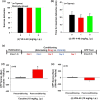(±)VK4-40, a novel dopamine D3 receptor partial agonist, attenuates cocaine reward and relapse in rodents
- PMID: 32851643
- PMCID: PMC7520435
- DOI: 10.1111/bph.15244
(±)VK4-40, a novel dopamine D3 receptor partial agonist, attenuates cocaine reward and relapse in rodents
Abstract
Background and purpose: Despite widespread abuse of cocaine, there are no approved treatments for cocaine use disorder. Chronic cocaine use is associated with up-regulated dopamine D3 receptor expression in the brain. Therefore, most D3 -based medication development has focused on D3 antagonists. However, D3 antagonists do not attenuate cocaine intake under "easy" self-administration conditions, when response requirements are low. We evaluated a novel, highly selective and metabolically stable D3 partial agonist, (±)VK4-40, for its efficacy in reducing cocaine intake and relapse to drug seeking.
Experimental approach: The impact of (±)VK4-40 on cocaine intake and relapse was evaluated using intravenous self-administration procedures under a fixed-ratio 2 reinforcement schedule and cocaine-primed reinstatement conditions in rats. Optogenetic brain-stimulation reward procedures were used to evaluate the interaction of (±)VK4-40 and cocaine in the mesolimbic dopamine system in mice. Sucrose self-administration in rats and a conditioned place preference paradigm in mice were used to evaluate the abuse potential of (±)VK4-40 alone and other unwanted effects.
Key results: (±)VK4-40 dose-dependently reduced cocaine self-administration and cocaine-primed reinstatement of drug-seeking behaviour. (±)VK4-40 also inhibited cocaine-enhanced brain-stimulation reward caused by optogenetic stimulation of dopamine neurons in the ventral tegmental area. (±)VK4-40 alone decreased brain-stimulation reward but produced neither conditioned place preference nor place aversion. This new D3 partial agonist also failed to alter oral sucrose self-administration.
Conclusion and implications: The novel D3 partial agonist, (±)VK4-40 attenuates cocaine reward and relapse in rodents, without significant unwanted effects. These findings support further investigation of D3 partial agonists as putative treatments for cocaine use disorder.
Keywords: addiction; brain-stimulation reward; cocaine; dopamine D3 receptor; optical intracranial self-stimulation; reinstatement; self-administration.
Published 2020. This article is a U.S. Government work and is in the public domain in the USA.
Conflict of interest statement
The authors declare no conflicts of interest.
Figures




References
-
- Alexander, S. P. H. , Roberts, R. E. , Broughton, B. R. S. , Sobey, S. G. , George, C. H. , Stanford, S. C. , … Ahluwalia, A. (2018). Goals and practicalities of immunoblotting and immunohistochemistry: A guide for submission to the British Journal of Pharmacology . British Journal of Pharmacology, 175, 407–411. 10.1111/bph.14112 - DOI - PMC - PubMed
-
- Ashby, C. R. Jr. , Rice, O. V. , Heidbreder, C. A. , & Gardner, E. L. (2015). The selective dopamine D(3) receptor antagonist SB‐277011A attenuates drug‐ or food‐deprivation reactivation of expression of coneditioned place preference for cocaine in male Sprague‐Dawley rats. Synapse, 69, 336–344. 10.1002/syn.21820 - DOI - PubMed
Publication types
MeSH terms
Substances
Grants and funding
LinkOut - more resources
Full Text Sources
Other Literature Sources
Medical
Molecular Biology Databases

